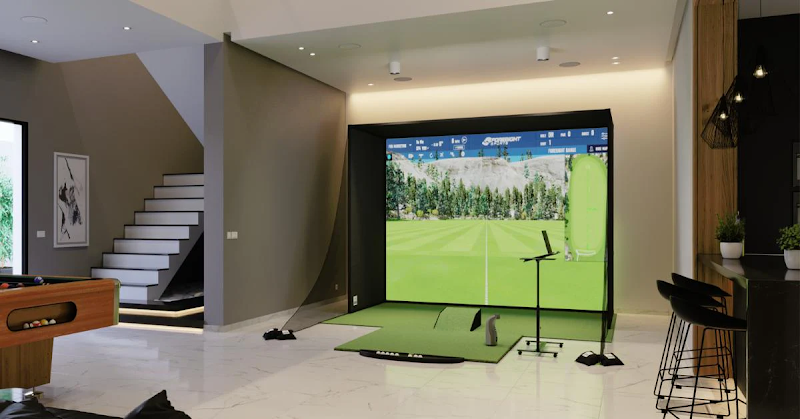Golf Simulators in 2025: Are They Really as Accurate as the Driving Range?
Golf technology has come a long way in recent years, and 2025 has brought some of the most sophisticated developments yet. Golfers at all levels—from casual players to touring pros—are turning to high-tech solutions for practice, especially when time, space, or weather limits access to the course. With the rise in popularity of indoor training, many are asking a crucial question: Can today’s golf simulators truly match the feel and accuracy of the driving range?
Let’s dive deep into this topic, explore the tech behind it, and break down whether simulators have earned their place alongside traditional practice methods.
What Makes a Golf Simulator “Accurate”?
Understanding the Core Technology
At the heart of every modern golf simulator is a system that combines high-speed cameras, radar, infrared sensors, and sophisticated algorithms to track your swing and ball flight. These technologies measure data points such as ball speed, launch angle, spin rate, and club path in real time.
The more data a system can capture—and the more precisely it does so—the more lifelike and accurate the feedback becomes. Premium simulators even account for environmental variables like wind, turf interaction, and temperature to provide realistic shot outcomes.
Real-Time Feedback vs. Real-World Conditions
One clear advantage of simulators is the instant feedback they offer. Players can analyze each swing with detailed metrics, something not easily achieved on a traditional range. However, simulators are typically set in a controlled indoor environment, which means the variables you face outdoors (wind gusts, uneven lies, different turf conditions) are often smoothed out or simulated digitally.
While this consistency is a strength for focused training, it may not fully replicate the unpredictability of the course or driving range.
Are Today’s Simulators Keeping Up With Reality?
Measurable Progress in 2025
Thanks to AI-enhanced shot modeling and hardware improvements, many of the best golf simulator systems today can reproduce ball flight and shot behavior with 95% or greater accuracy. The introduction of ultra-high-speed tracking cameras—some capable of capturing 10,000 frames per second—has narrowed the gap significantly between virtual and real-world performance.
Some simulators now include adjustable hitting surfaces to simulate rough, fairway, and bunker conditions. This brings a new layer of realism to indoor practice that was barely imaginable just a few years ago.
Professional-Grade Validation
Top-tier golf instructors and even professional players are increasingly integrating simulators into their practice routines. Players use them not just for swing work but also for course strategy, mental conditioning, and data-driven improvements. When calibrated correctly, a golf simulator can mirror how a shot would behave on the course with remarkable accuracy.
However, it’s important to note that not all simulators are built equally. Entry-level models may still fall short in terms of shot shape realism, misreading certain swing types or failing to capture subtle nuances in clubface angles.
Key Differences Between Simulator and Driving Range Practice
Controlled vs. Natural Environments
One of the biggest trade-offs between using a simulator and going to the range is the environment. Simulators provide a controlled space where distractions and external variables are minimized, allowing for focused, repeatable practice. This is ideal for working on mechanics, analyzing swing data, and building consistency.
On the other hand, the driving range offers the benefit of real-world ball flight, wind impact, and natural ground interaction—factors that can influence shot results significantly. Practicing outside also helps players develop better feel and adaptability, which are critical in competitive settings.
Mental Engagement and Feedback
Another often-overlooked aspect is the psychological element. Practicing on a range, especially with targets at various distances, can sharpen a player’s decision-making and focus. Simulators now replicate this through virtual courses and skills challenges, but some players still find the indoor experience less mentally stimulating than being outdoors.
Practical Tips: Making the Most of Your Simulator Practice
1. Use High-Quality Equipment
To get the most accurate experience, invest in a simulator that uses dual tracking technology (camera + radar). Brands like TrackMan, Foresight Sports, and Full Swing offer some of the most trusted options in the industry.
2. Calibrate and Update Regularly
Even the best golf simulator needs routine calibration. Make sure your equipment is updated and recalibrated regularly to maintain shot accuracy, especially if you’re using it for club fitting or game improvement.
3. Blend Sim Practice With On-Course Play
Use the simulator for swing analysis, distance control, and virtual course play—but complement it with range sessions when possible. This hybrid approach helps reinforce both mechanics and adaptability.
4. Focus on One Metric at a Time
Avoid data overload. Pick one metric to work on per session (e.g., club path or launch angle) to stay focused and avoid chasing too many variables at once.
Conclusion
While golf simulators in 2025 aren’t perfect replicas of the driving range, they are impressively close. The technology has matured to a point where, for many golfers, simulators offer a more productive and accessible alternative to outdoor practice. With advanced tracking, immersive software, and customizable conditions, they’ve become indispensable tools for game improvement.
Whether you’re a weekend warrior or a scratch player, integrating simulator sessions into your routine can elevate your training, offering convenience without sacrificing quality.






